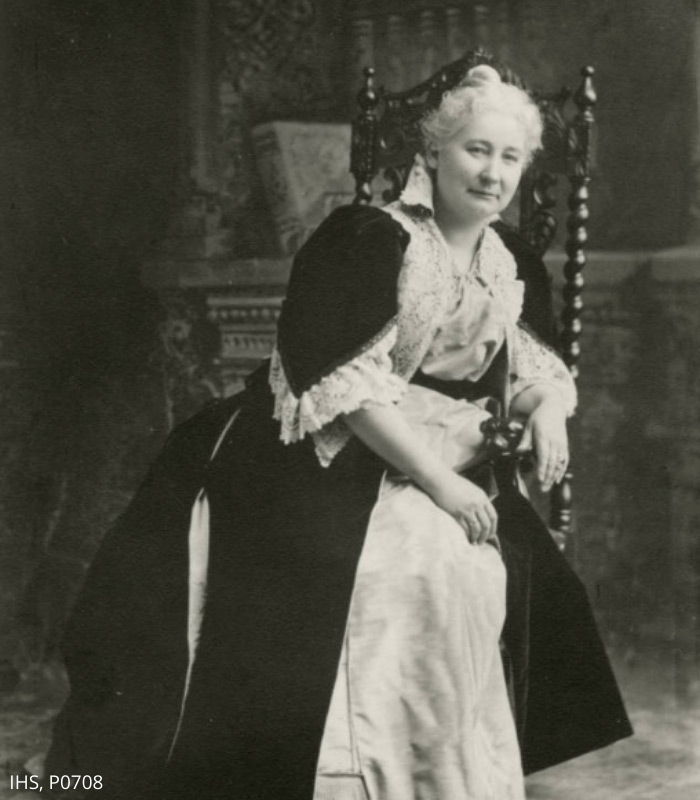In Celebration: 100-Year Anniversary of Women’s Right to Vote
 May (Mary Elizabeth) Wright Sewall (May 27, 1844—July 22, 1920)
May (Mary Elizabeth) Wright Sewall (May 27, 1844—July 22, 1920)
“I never left Mrs. Sewall’s presence without resolving to be more outspoken in good causes, more constant in their service, without a fresh resolve to let trivial concerns go and emphasize only really vital interests … What she wrought will endure and generations yet unborn will find life a fuller and richer experience because she joined in the effort to make it so instead of supinely accepting conditions as they were.” Grace Julian Clarke, herself a suffragist.
In his introduction to May’s book, Neither Dead Nor Sleeping, published in 1920, the author Booth Tarkington wrote that “in company with President Harrison and the poet James Whitcomb Riley, May Wright Sewall would necessarily be chosen as one of the three most prominent citizens of Indiana.” And even in the year 2000, a poll of readers of the Indianapolis Star voted May the 44th greatest Hoosier of the 20th Century, which doesn’t seem so bad when you consider Reggie Miller came in 45th.

Mary Elizabeth Wright was born in Wisconsin, the daughter of a former school teacher who encouraged her to become a teacher herself. She moved to Indianapolis with her first husband, Edwin, another teacher, in 1874, to teach English and German. But already she was becoming socially active, helping to start the Indianapolis Women’s Club in 1875, a few months before Edwin’s death from tuberculosis. By 1878 she was meeting with a clandestine group of nine women and one man to discuss forming a suffragette group in Indianapolis and by their second meeting, May was selected to attend a national meeting in Rochester, N.Y. Her speech there brought her into contact with the leaders of the movement and she became one of Susan B. Anthony’s “most competent young lieutenants” in the National Woman Suffrage Association.
While she was finding her place in that movement, she also found herself attracted to new Harvard educated teacher in town, Theodore Sewall, who had opened the Indianapolis Classical School. The feeling was mutual, and they were married on October 31, 1880, and she began teaching German and English in his school before opening a Girl’s Classical School in 1882, mostly adopting the same curriculum as the school for boys. In the evenings, the couple also hosted literary and cultural discussions that eventually led to the forming of the Art Association in 1883, a group the later evolved into the Herron School of Art and the Indianapolis Museum of Art.
After traveling to Milwaukee to give a lecture, May became so impressed with the local women’s clubs there that she returned inspired to start a club in Indianapolis that would be housed in their own building. The Indianapolis Propylaeum, the resulting club, purchased the land for their building in 1888 and dedicated their building at 17 East North Street on January 27, 1891.
But tragedy soon followed. For the second time in her life, May had to stand by while her husband battled tuberculosis. Despite trips to sanitariums all across the country, Theodore died at home on December 23, 1895. His last words were “Tell the girls that to be well and to be at work are the two conditions of happiness.” May, dealt this blow a second time, was too grief stricken to attend his memorial service, and buried herself in her work to drown her pain.
She eventually sold the Girl’s School to a former pupil and became more involved with her work in the women’s movement. Her great contribution to the movement became known as “the council idea.” Noting that women were most often “interested in women of their own class or in the legitimate recipients of their own charities,” she sought to bring the leaders of these various groups together into councils where women of varied backgrounds, traditions, wealth, social position, religion and political opinions would see their common bonds and goals and that the “likenesses existing among the most different classes of women were larger than the differences among the same classes.” She served as president of the International Council of Women from 1899-1904 and traveled throughout Europe on behalf of the group. Harper’s Bazaar in June 1900 referred to Sewall as the leader of over five million women because of her work with the council.
May devoted much of the rest of her life working on behalf of world peace as part of the platform of the International Council, a cause that didn’t meet with much success as World War I developed. Then she died on July 22, 1920, not quite a month before the 19th Amendment, giving women the right to vote, was ratified on August 18th. Almost as a fulfillment to Tarkington’s words in his introduction, she is buried near to President Harrison, poet Riley, and even Tarkington himself.
May Wright Sewall is buried at Section 13, Lot 24 in Crown Hill Cemetery. For more photos of May visit these links, courtesy of the Indiana Historical Society: May Wright Sewall (1): http://ow.ly/sH4530qoNZ5 ; May Wright Sewall Young: http://ow.ly/Xekw30qoNZf

